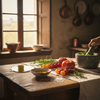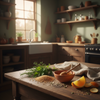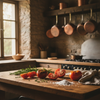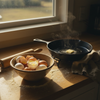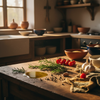Dutch Oven Cooking: Your Complete Guide To Rich Flavors
The Magic of Dutch Oven Cooking: Where Tradition Meets Culinary Adventure
There's something almost magical about lifting the heavy lid of a Dutch oven to reveal a perfectly tender roast chicken, surrounded by caramelized vegetables swimming in their own savory juices. That moment—when the steam billows up and the aromas hit you—is what Dutch oven cooking is all about. It's not just cooking; it's an experience that transforms simple ingredients into meals that tell stories.
If you've ever watched someone cook with a Dutch oven, you've witnessed the quiet confidence that comes from using a tool that's been perfecting meals for centuries. At DI ORO, we believe the best cooking happens when quality tools meet creative spirits—and few cooking vessels inspire creativity quite like the humble yet mighty Dutch oven.
Whether you're a Dutch oven newbie or looking to elevate your cast iron game, this guide will take you through everything you need to know about this versatile cooking companion that deserves a permanent spot in your culinary arsenal.
What Exactly Is Dutch Oven Cooking?

Dutch oven cooking is essentially the art of preparing food in a thick-walled cooking pot with a tight-fitting lid. But calling it just a "pot" is like calling a Ferrari just a "car"—technically accurate but missing the magic entirely.
These kitchen workhorses excel at maintaining consistent heat, creating the perfect environment for everything from baking artisan bread to simmering complex stews. The beauty of Dutch oven cooking lies in its versatility—it moves effortlessly from stovetop to oven, making it the ultimate one-pot wonder for home chefs who dream big but prefer cleaning small.
What sets Dutch oven cooking apart is how it transforms ordinary ingredients into extraordinary meals through heat retention and moisture circulation. The heavy lid traps steam, creating a mini ecosystem where flavors meld and meats become fork-tender. It's like having a personal flavor scientist working tirelessly on your behalf.
From Campfire to Kitchen: The Evolution of Dutch Oven Cooking
Dutch ovens weren't born in modern kitchens—they earned their stripes over open flames and hot coals. These culinary workhorses have been feeding hungry adventurers, pioneers, and families for generations. Early American settlers relied on them so heavily that some considered them family heirlooms, passing them down through generations along with the recipes perfected in them.
The Dutch oven has played a starring role in countless cultural cooking traditions. From South African potjiekos (layered stews cooked over coals) to America's chuck wagon cooking on cattle drives, these versatile vessels have shaped how communities gather around food. Even today, Scout troops continue this tradition, creating memorable meals and teaching young cooks that sometimes the best kitchen technology is centuries old.
What began as a practical solution for cooking over open flames has evolved into a beloved method embraced by home cooks and professional chefs alike. Modern Dutch ovens may come in vibrant colors with enamel coatings, but their soul remains unchanged—they're still about bringing people together around remarkably good food.
Choosing Your Perfect Dutch Oven
Standing in front of the dizzying array of Dutch ovens can feel like trying to pick the perfect avocado—overwhelming and consequential. But fear not! Finding your Dutch oven soulmate comes down to understanding the main types and knowing what you'll be cooking.
Cast Iron vs. Enameled: The Great Debate
Traditional cast iron Dutch ovens are the rugged pioneers of the bunch. They're virtually indestructible, develop a natural non-stick surface over time, and can handle everything from campfire cooking to oven baking. The downside? They require ongoing seasoning and maintenance—think of them as the high-maintenance partner who's totally worth the effort.
Enameled cast iron Dutch ovens offer the heat retention benefits of traditional cast iron but with a glass-like coating that eliminates the need for seasoning. They're perfect for acidic foods like tomato-based sauces that might react with bare cast iron. The smooth interior also makes cleanup a breeze—just don't use metal utensils that might chip that beautiful enamel. (This is where DI ORO's silicone spatulas come in handy—they're gentle on surfaces while still being heat-resistant up to 600°F.)
For those who prioritize portability, aluminum Dutch ovens offer a lightweight alternative that's particularly popular among backpackers. They won't retain heat quite like cast iron, but they'll be much kinder to your back on long treks.
Size Matters: Finding Your Perfect Fit
Dutch ovens typically range from petite 2-quart models to massive 13-quart giants that could feed a small village. For most home cooks, a 5-6 quart Dutch oven hits the sweet spot—large enough for a family meal but not so unwieldy that you need a workout before lifting it.
When choosing your size, consider what you'll be cooking most often. Planning to master dutch oven cooking chicken? A 5-quart will comfortably fit a whole bird with vegetables. Dreaming of crusty artisan bread? A 6-quart round model creates the perfect environment for that crackling crust. For larger families or enthusiastic entertainers, sizing up to 7-8 quarts provides welcome extra space.
Remember that these pots are heavy even when empty—a 6-quart enameled cast iron Dutch oven can easily weigh 15 pounds before you add food. Make sure you can comfortably lift whatever size you choose, especially when it's full and hot.
Features Worth Noticing
Not all Dutch ovens are created equal, and small design differences can significantly impact your cooking experience. Look for these thoughtful features:
- Lid design: Self-basting lids with little bumps or ridges help moisture drip back onto your food rather than evaporate. For outdoor cooking, a rimmed lid allows you to place coals on top for even heating.
- Handle comfort: Wide, easy-to-grip handles make all the difference when you're maneuvering a heavy, hot pot. Some models feature ergonomic designs or heat-resistant coatings.
- Interior color: While mostly aesthetic, light-colored interiors make it easier to monitor browning and fond development—crucial for building flavor in many cast iron dutch oven recipes.
- Bottom shape: Flat bottoms work best on modern stovetops, while those with legs are designed specifically for campfire cooking.
Preparing Your Dutch Oven for Culinary Greatness

Whether you've just unboxed your first Dutch oven or you're dusting off a neglected heirloom, proper preparation sets the stage for cooking success. Think of it as the difference between cooking in a rental kitchen versus one that's truly yours—it's all about creating the right conditions.
Seasoning: The Foundation of Cast Iron Dutch Oven Cooking
For traditional cast iron Dutch ovens, seasoning isn't optional—it's essential. This process creates a natural non-stick surface and protects your pot from rust. Even if your Dutch oven comes "pre-seasoned," giving it an additional seasoning boost before first use will improve its performance.
Mastering Dutch Oven Cooking Techniques
The true magic of Dutch oven cooking happens when you understand how to harness its unique properties. It's like having a secret superpower in your kitchen arsenal—one that transforms tough cuts of meat into tender delicacies and simple ingredients into complex, layered flavors. Let's dive into the techniques that will elevate your Dutch oven game from amateur to impressive.
Heat Management: The Heart of Dutch Oven Cooking
Whether you're cooking over coals, on a stovetop, or in an oven, temperature control is your most powerful tool. Unlike thin pots that heat quickly and unevenly, Dutch ovens are the marathoners of the kitchen world—slow to heat up but remarkably steady once they get there.
For stovetop cooking, start with a lower heat than you might instinctively use. Dutch ovens retain heat so efficiently that medium-low often works better than high heat, which can lead to scorched food and temperature spikes. Think of it as a dance—you're partnering with your Dutch oven, not forcing it to follow your lead.
When using your Dutch oven outdoors, the classic formula for temperature control is counting coals. For a 12-inch Dutch oven, the rule of thumb is: cooking temperature in degrees Fahrenheit divided by 25 equals the total number of coals needed. Place roughly one-third of the coals under the oven and two-thirds on the lid for even heating. It's not rocket science, but it is deliciously reliable kitchen physics.
For more detailed tips on managing heat and coals, check out this guide on Dutch oven cooking tips.
One Pot, Many Methods: Versatile Dutch Oven Cooking Techniques
The beauty of Dutch oven cooking lies in its versatility. Here's how to master various cooking methods with your new favorite kitchen tool:
- Braising: The Dutch oven's specialty. Brown meat on the stovetop, add liquid to about halfway up the meat, cover, and transfer to a 325°F oven until fork-tender. This transformation of tough cuts into meltingly tender morsels is where Dutch ovens truly shine.
- Baking: With its ability to maintain steady heat and humidity, your Dutch oven creates the perfect environment for crusty breads and bubbling cobblers. Preheat the Dutch oven in a hot oven before adding bread dough for that professional-quality crust.
- Deep frying: The heavy bottom and excellent heat retention make Dutch ovens ideal for maintaining oil temperature—crucial for crispy, not greasy, fried foods.
- Slow cooking: Set your oven to 250-275°F, and your Dutch oven becomes the original slow cooker, perfect for developing complex flavors over hours.
Remember that DI ORO's silicone spatulas are perfect companions for Dutch oven cooking—they won't scratch enamel surfaces, can handle the high heat, and their flexible edges get into every corner of your Dutch oven without damaging that precious seasoning or enamel.
Explore more about the versatility of Dutch oven cooking at Cozymeal's Dutch oven cooking magazine.
Dutch Oven Cooking Chicken: A Masterclass in Flavor
If there's one dish that showcases the brilliance of Dutch oven cooking, it's chicken. The enclosed environment creates self-basting magic that results in juicy meat and crispy skin—the holy grail of poultry perfection.
For a simple yet spectacular Dutch oven chicken, try this approach: Season a whole chicken generously with salt and pepper, then place it breast-side up in a preheated Dutch oven. Surround it with chunks of onion, carrots, celery, and whole garlic cloves. Add a splash of white wine or chicken broth, cover, and roast at 375°F for about an hour. Remove the lid for the final 15-20 minutes to crisp the skin. The result? A chicken that's juicy inside with crackling skin, surrounded by vegetables that have essentially confited in the rendered chicken fat.
For chicken parts rather than a whole bird, brown them skin-side down first, then flip, add your aromatics and liquid, and finish covered in the oven. This technique works beautifully for thighs, which become fall-apart tender while developing deep flavor.
Learn more secrets to perfect Dutch oven chicken cooking at Design Mom's Dutch oven cooking secrets.
Dutch Oven Recipes: From Classic to Creative

Now that you've got the techniques down, let's talk about what to cook in your Dutch oven. While you could certainly find inspiration in any dutch oven cooking book, we've gathered some tried-and-true favorites that showcase what these versatile vessels do best.
One-Pot Wonders: Cast Iron Dutch Oven Recipes
The beauty of Dutch oven cooking is that it often requires just one pot from start to finish—meaning less cleanup and more layered flavors. Here are some cast iron Dutch oven recipes that will make you wonder why you ever cooked any other way:
- No-Knead Bread: Mix flour, water, salt, and a tiny bit of yeast. Let it rise overnight, then bake in a preheated Dutch oven. The result? Artisan-quality bread with a crackling crust that would make a professional baker proud.
- Beef Bourguignon: The ultimate Dutch oven showcase. Brown beef chunks, add onions, carrots, mushrooms, red wine, and herbs. Let it simmer low and slow until the meat practically melts. Julia Child would approve.
- Jambalaya: Brown sausage and chicken, add the holy trinity (onions, celery, bell peppers), rice, stock, and spices. The Dutch oven's even heat prevents the dreaded scorched bottom while ensuring perfectly cooked rice.
For those new to Dutch oven cooking, start with forgiving recipes that showcase the pot's strengths. Soups, stews, and braises are particularly foolproof and build confidence while delivering incredible results.
Unexpected Dutch Oven Delights
While Dutch ovens excel at traditional recipes, they're also perfect for unexpected culinary adventures:
- Deep-Dish Pizza: Press dough into a well-oiled Dutch oven, add toppings, and bake covered for a Chicago-style pizza experience at home.
- Whole Roasted Cauliflower: Blanch a head of cauliflower, coat with spiced yogurt, and roast in your Dutch oven until tender inside and caramelized outside.
- Overnight Oats for a Crowd: Combine steel-cut oats, water, milk, and flavorings in your Dutch oven. Bring to a simmer, cover, and place in a 200°F oven overnight. Wake up to perfectly cooked oatmeal.
Don't be afraid to adapt your favorite recipes for Dutch oven cooking. The worst that can happen is a learning experience; the best is discovering a new family favorite method.
Desserts: The Sweet Side of Dutch Oven Cooking
Dutch ovens aren't just for savory dishes—they're secret weapons for desserts too. The even heat creates perfect conditions for:
- Cobblers and Crisps: The Dutch oven creates the perfect environment for bubbling fruit beneath a golden topping. Try peach cobbler in summer or apple crisp in fall.
- Molten Chocolate Cake: Mix the batter directly in your Dutch oven, bake until the edges are set but the center remains gooey, and serve with vanilla ice cream for a showstopping finale.
- Cinnamon Rolls: Particularly impressive when camping—nothing beats the smell of cinnamon rolls baking over morning campfire coals.
For outdoor dutch oven cooking, desserts are particularly impressive. There's something magical about lifting the lid to reveal a perfectly baked dessert when you're miles from the nearest oven.
Troubleshooting Your Dutch Oven Cooking
Even seasoned Dutch oven enthusiasts encounter challenges occasionally. Here's how to solve common issues:
When Good Dutch Oven Cooking Goes Bad
If you're experiencing these common problems, try these solutions:
- Food sticking to the bottom: Your heat is likely too high. Lower the temperature and make sure you've adequately oiled or seasoned your pot.
- Burnt exterior but raw interior: Your Dutch oven is probably too hot. Next time, lower the heat and extend the cooking time to allow heat to penetrate more gradually.
- Watery stews: Remove the lid for the final portion of cooking to allow excess moisture to evaporate and flavors to concentrate.
- Tough meat after long cooking: You might need even more time. Some cuts require 3+ hours to break down completely. Patience is rewarded in Dutch oven cooking.
Remember that Dutch oven cooking is as much art as science. Each pot has its own personality, and learning its quirks is part of the journey. With DI ORO's tools by your side and a willingness to learn, you'll be creating Dutch oven masterpieces in no time. For more tips on essential utensils, check out our best cooking utensils guide. If you want to learn about the benefits of using a rubber scraper for your Dutch oven, we've got you covered. Looking for a delicious side? Try our roasted asparagus recipe that pairs perfectly with Dutch oven mains. And for a hearty breakfast, don't miss our kale egg bake—another one-pot wonder.
Creating Your Dutch Oven Legacy

Dutch oven cooking isn't just about following recipes—it's about creating traditions. Whether you're simmering a family chili recipe that's been passed down for generations or experimenting with a new sourdough technique, your Dutch oven becomes more than cookware—it becomes a vessel for memories. Let's explore how to build your own Dutch oven legacy.
Building Your Dutch Oven Recipe Collection
Every dutch oven cooking enthusiast needs a repertoire of go-to recipes. Start with classics that showcase what Dutch ovens do best, then branch out with your own creative twists. Keep a dedicated notebook (digital or physical) of your Dutch oven successes—and yes, even the failures. Those "learning experiences" often lead to the most delicious discoveries!
While there are countless dutch oven cooking books available, creating your personal collection allows you to note your specific adjustments—like "add extra garlic" or "reduce cooking time by 15 minutes for my oven." These personalized notes transform good recipes into perfect ones tailored to your taste and equipment.
Some enthusiasts even create family dutch oven cooking recipes books, complete with photos and stories. There's something deeply satisfying about documenting the evolution of your Dutch oven journey and sharing it with others who appreciate the art.
Seasonal Dutch Oven Cooking
One of the joys of Dutch oven cooking is how beautifully it adapts to seasonal ingredients and weather patterns. Your cooking style can evolve with the calendar:
- Spring: Lighter braises featuring early vegetables like asparagus and peas
- Summer: Dutch oven cooking outdoors to keep kitchens cool; fruit cobblers and campfire meals
- Fall: Hearty stews, apple desserts, and bread baking as temperatures drop
- Winter: Slow-cooked comfort foods that warm both body and soul; perfect for snow days
This seasonal approach not only maximizes flavor (ingredients at their peak simply taste better) but also creates annual traditions to anticipate. That first autumn pot of chili or summer peach cobbler becomes a celebration of the season itself. For more Dutch oven inspiration, try our Cowboy Butter Chicken Wings recipe for a crowd-pleasing meal. If you love grilling, our grilling chicken thighs guide offers tips that translate beautifully to Dutch oven cooking. Don't forget about prep—see why kitchen scissors are a must-have for trimming meats and veggies before they hit the pot. And for a unique twist, explore our homemade weed killer recipe to keep your herb garden thriving for fresh Dutch oven ingredients!
Dutch Oven Community: Sharing the Love
Dutch oven cooking has a way of bringing people together. From Scout troops to competitive cooking clubs, these humble pots create communities. Connecting with fellow enthusiasts can elevate your cooking through shared knowledge and inspiration.
Finding Your Dutch Oven Tribe
Look for Dutch oven gatherings in unexpected places. County fairs often feature Dutch oven competitions where you can witness masters at work. Historical reenactment groups frequently use period-appropriate cooking methods, including Dutch ovens. Online communities dedicated to cast iron dutch oven recipes provide virtual camaraderie and troubleshooting.
Don't be shy about sharing your own experiences. Post photos of your Dutch oven triumphs (and yes, even the occasional disaster—we all have them). Ask questions when you're stuck. The Dutch oven community is remarkably generous with knowledge and encouragement.
For those ready to take their passion public, consider organizing a neighborhood Dutch oven cookoff or demonstration. There's something magical about lifting a lid to reveal a perfectly baked creation while surrounded by appreciative onlookers. Plus, everyone gets to eat the results!
Dutch Oven Cooking: From Novice to Mentor
Remember the first time you successfully made that crusty no-knead bread or perfectly tender dutch oven cooking chicken? That feeling of accomplishment is worth sharing. As your confidence grows, consider mentoring others just starting their Dutch oven journey.
Teaching someone else cements your own knowledge and keeps traditions alive. Whether it's showing your children how to manage coals for outdoor cooking or helping a neighbor season their first cast iron pot, passing on Dutch oven skills creates ripples of culinary joy that extend far beyond your kitchen.
With your trusty DI ORO silicone tools in hand (which, unlike metal utensils, won't damage your carefully maintained seasoning), you can demonstrate techniques with confidence, knowing you're protecting both your cookware and your food with forever-chemical-free tools.
The Future of Dutch Oven Cooking
While Dutch ovens have centuries of history behind them, they're anything but outdated. In fact, they're experiencing a renaissance as cooks rediscover the joy of slow food and analog cooking in our digital world.
Modern Twists on Timeless Techniques
Today's Dutch oven enthusiasts are blending traditional methods with contemporary flavors. Global ingredients are finding their way into these heritage pots—think Moroccan tagines, Korean-inspired short ribs, or Indian butter chicken. The Dutch oven adapts beautifully to these cross-cultural explorations while maintaining its fundamental strengths.
Social media has created new platforms for sharing dutch oven cooking recipes and techniques. Time-lapse videos of bread rising or slow-motion captures of the moment a lid is lifted from a bubbling cobbler have introduced Dutch oven cooking to new generations of food enthusiasts.
Even in our convenience-focused world, there's growing appreciation for the mindfulness that Dutch oven cooking encourages. The process requires presence—checking, stirring, adjusting. In return, it offers not just meals but moments of connection with our food and each other.
Sustainability and Dutch Oven Cooking
As environmental concerns grow, Dutch ovens offer a surprisingly eco-friendly cooking option. Their durability means they often last for generations—the ultimate in sustainable cookware. Their energy efficiency is remarkable; once hot, they require minimal additional heat to maintain temperature.
Dutch ovens also excel at transforming less expensive, tougher cuts of meat into tender delicacies through slow cooking. This aligns perfectly with nose-to-tail eating philosophies that reduce food waste. Similarly, their one-pot nature makes them ideal for using up vegetable odds and ends in soups and stews.
When paired with DI ORO's durable, high-performance silicone tools, you create a cooking system designed to last for years—reducing waste while elevating your culinary results.
Your Dutch Oven Journey: The Next Chapter
Whether you're just unwrapping your first Dutch oven or you're a seasoned pro with decades of experience, there's always something new to discover. The beauty of Dutch oven cooking lies in this endless potential for growth and exploration.
Start where you are. If you're new to Dutch oven cooking, begin with forgiving recipes like no-knead bread or a simple chicken stew. If you're experienced, challenge yourself with new techniques—perhaps sourdough baking or recreating restaurant favorites.
Document your journey. Take notes on what works and what doesn't. Photograph your creations. Share your successes. Each dish builds your confidence and expands your repertoire.
Most importantly, enjoy the process. Dutch oven cooking invites us to slow down in a world that rarely does. It rewards patience with incredible flavors and textures that simply can't be rushed. In that way, it's not just about cooking—it's about reclaiming a more intentional relationship with our food.
With your Dutch oven and DI ORO tools in hand, you're equipped for culinary adventures limited only by your imagination. From hearty stews that warm winter evenings to crusty breads that make your kitchen smell like heaven, your Dutch oven stands ready to transform simple ingredients into memorable meals.
So lift that lid, stir that pot, and savor not just the food but the experience of creating it. Your Dutch oven journey is just beginning, and the possibilities are as endless as they are delicious.
Explore DI ORO Collections
Frequently Asked Questions
What do you cook in a Dutch oven?
A Dutch oven is incredibly versatile and can be used to cook a wide variety of dishes including stews, soups, braises, roasts, bread, and even deep-fried foods. Its heavy, thick walls provide excellent heat retention and distribution, making it perfect for slow-cooking and simmering meals to develop rich flavors. You can also use it for baking artisan bread or preparing one-pot meals that require even cooking.
What is the rule of 3 Dutch oven?
The Rule of 3 in Dutch oven cooking is a simple guideline for seasoning meats or vegetables before cooking: use 3 parts salt, 3 parts fat (like oil or butter), and 3 parts sugar. This balance helps create a flavorful crust and enhances caramelization during cooking. It’s a helpful tip for beginners to achieve delicious results when roasting or braising in a Dutch oven.
What are 10 reasons to use a Dutch oven?
Ten reasons to use a Dutch oven include its versatility for cooking many dishes, excellent heat retention, ability to go from stovetop to oven, durability for years of use, capability to develop deep flavors through slow cooking, suitability for baking bread, ease of cleaning with enamel coatings, even heat distribution, suitability for outdoor cooking like camping, and its classic, timeless design that fits any kitchen.
What does it mean when someone says they are going to the Dutch oven you?
When someone says they are going to ‘Dutch oven you,’ it usually refers to the playful act of pulling the covers over someone’s head while they are sleeping, causing them to breathe in their own trapped breath. It’s a humorous and lighthearted prank often shared among family or close friends, rather than anything related to cooking or the actual Dutch oven cookware.
What is the hype with Dutch ovens?
The hype around Dutch ovens comes from their unmatched versatility and reliability in the kitchen. Food enthusiasts love how they can effortlessly handle a wide range of recipes, from slow-cooked stews to freshly baked bread, all while providing consistent heat. Their durability and timeless design also make them a beloved heirloom piece that many cooks swear by for creating delicious meals.
What is the best use of a Dutch oven?
The best use of a Dutch oven is slow-cooking dishes that benefit from even heat and moisture retention, such as braises, stews, and soups. Its heavy lid traps steam, which keeps food tender and flavorful, making it ideal for recipes that require long simmering times. Additionally, it excels at baking crusty bread and roasting meats to perfection.
